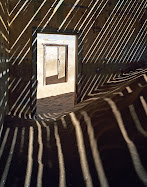 To make or not to make...
To make or not to make...On a recent trip to Scotland with a workshop group we twice visited Loch Clair in Glen Torridon for dawn. On both occasions the light was stunning, with the mountain Liathach bathed in a deep red glow for around ten to fifteen minutes – a time period consistent with an LF photographer being able to capture an image! On the group's second visit the cloudscape was amongst the finest that I have ever witnessed. On both occasions the other photographers in the group worked feverishly to capture something of the beauty laid out before them. Yet I found myself unmotivated to make an image. The scene was sublime yet, despite the abundant water, it singularly failed to float my boat.
I began to think that perhaps there was something wrong with me (highly likely). What exactly was stopping me making a picture. I know I'm not known as 'Mr Vista' but I do like a wide view so that didn't seem a likely explanation. There had to be something about this particular wide view that was inhibiting the action of my trigger finger. This worried me for the rest of the workshop. As a landscape photographer how could I not make an image of such an amazing sight? One thought was that maybe it was because I'd seen it before. In truth, not this particular view but similar ones. I don't like to feel that I'm repeating myself so I often conduct a kind of internal examination (ooh, err missus!) of my motives to make sure that I'm not taking the easy route and treading exactly the same well worn path. To add another twist, it had long been an ambition of mine to make an image across Loch Clair in great dawn light. Yet I literally couldn't make the image. No matter how hard part of me wanted to I couldn't bring myself to put the camera on the tripod. Perhaps I was just losing enthusiasm for landscape photography, becoming jaded after years of chasing the light. Perhaps it was time to pack away the dark cloth...
Then, a few days later (on a different continent) a scene grabbed me by the throat and I felt compelled to make an image. Any thoughts of being jaded disappeared in the instant that I recognised the possibility for the image. No longer "a washed up has-been" I returned to the problem of why I couldn't make the earlier image. It occurred to me that though I had hugely enjoyed the experience of those dawns I had also instinctively known that any image I made would be a pale ghost of the depth of feeling that I had experienced. What I had experienced was literally ineffable and any image of it would lack depth and subtlety. It would have had an undeniable attractive, but superficial, gloss imparted by the amazing light but in fact the strength of that light would be counter productive; any hope for subtlety and richness drowned in a crimson flood. Evocations beyond 'Gosh!' or 'warm' beaten to a blood red pulp. The point I'm trying to make is that sometimes you can't say what you feel in a single image. Its range is too poor, its sensory inputs too restricted. I'm not likely to take up cinematography any time soon but it is important to realise the limits.
Like many things it's blindingly obvious once you know it. But it surprised me that it has taken me quite so long to make the realisation. Obviously I've been 'not-making' images for decades, taking the decision to move on and find something else. But usually this was because the subject failed some quality test of my own devising or that what I was striving to achieve was beyond my reach technically, not because simply it was too good. Perhaps it's just another excuse to not take the camera out of the bag, or perhaps it's a sign of some late-found maturity in my photography. I hope it may be.




